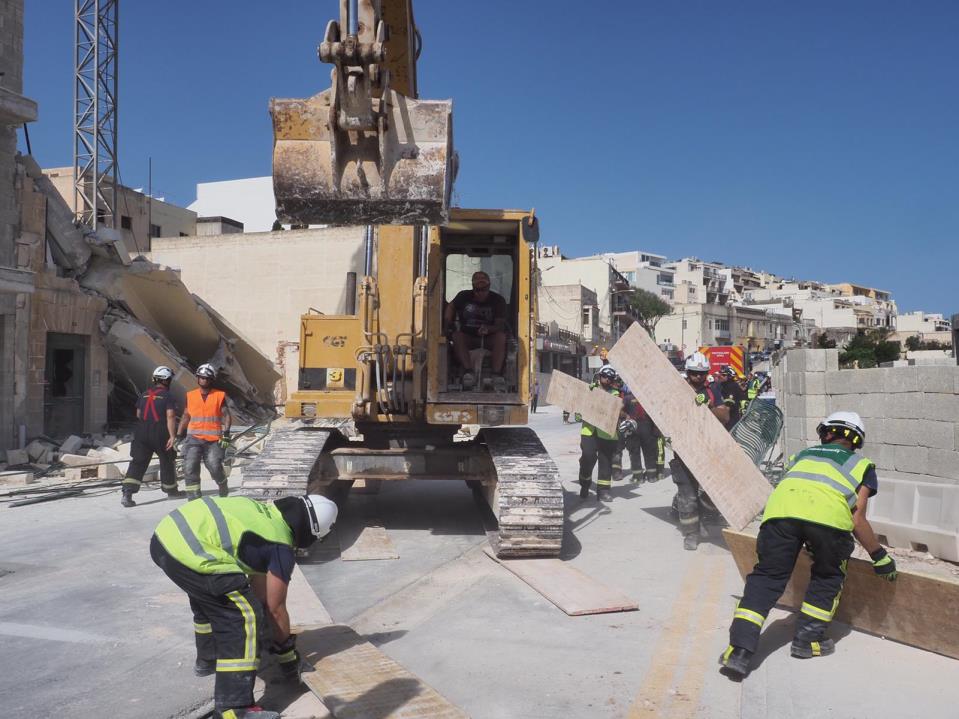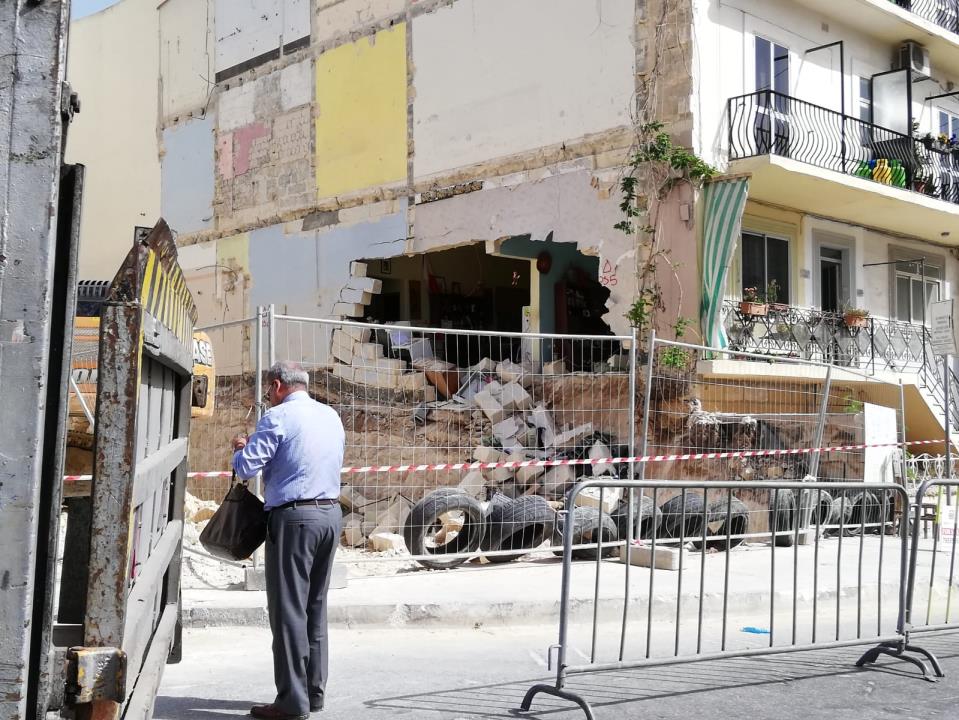The introduction of the need for a Geotechnical Design Report and the stipulation of much harsher fines for contraveners are among the main changes found within the new draft of the Avoidance of Damage to Third Party Property Act.
Launched on Monday morning by the Ministry for Transport, Infrastructure, and Capital Projects, the draft Act was fast-tracked after the collapse of two buildings in the space of a few days last week.
Last week the government had also announced that all excavation and demolition works were suspended until the new regulations are in place.
The main addition to the draft bill is that when a project involves excavation, the developer must ensure that a proper structural investigation of the zone that is going to be excavated is carried out through the submission of a Geotechnical Design Report.
This report should, according to the draft act, include measures which will be taken so that the integrity of contiguous walls and infrastructure is not compromised once works are carried out, while a structural appraisal of the surrounding environment which should include a geotechnical investigation if the architect deems fit should also be carried out.
The architect who prepares this Geotechnical Design Report should, according to the draft act, meticulously follow the progress of works to see that they are following that which is stipulated within the report, take corrective measures where needed, approve the structural design of the foundations, and certify that the works have followed his instructions.

The architect also has to certify that after the necessary excavations are completed, the site is secure and safe for further construction works to begin.
Professional responsibility for the content and measures stipulated within the Geotechnical Design Report falls on the architect who prepared it, but the professional responsibility for the implementation of the Report (and of the method statement) falls on the contractor.
The Geotechnical Design Report is defined in the draft law as following the description given by Eurocode EN 1997-1, which is a European Standard primarily concerned with the requirements for strength, stability, serviceability and durability of structures.
Over 4,000% increase in maximum fine if enforcement orders are ignored
The draft law has also significantly increased fines for the ignorance of an enforcement order and for failure to adhere to the method statement that is adhered to.
In fact, the maximum fine for a failure to confirm acceptance of an enforcement notice issued by the Building Regulations Office (BRO) Director; a failure to stop works when instructed to by an enforcement notice; adoption of measures which are not sanctioned by the BRO Director; and somehow breaking any stipulated point in an enforcement order has risen from €1,200 to €50,000 – an increase of 4,167% - while the €100 fine that was imposed for every day the law breach continues has also risen to €1,000.
The maximum fine for failing to adhere to the method statement as stipulated within the draft act has also risen from €500 to €10,000, while the €100 fine that was imposed for every day the failure to adhere to it continues has also risen to €500.
The maximum fine for the late, incomplete or unsatisfactory submission of a method statement has meanwhile remained the same (€500 and a subsequent €100 fine for every subsequent day that the law is broken), as has the maximum fine for making a false declaration (€1,500).

Onus of proof that regulations were followed rests solely with the developer
A significant difference between the draft law and the currently enacted law noted by this newsroom is that the clause regarding onus of proof has been changed.
In terms of onus of proof, the currently enacted legislation stipulates that “should any damage result to third party property or should there be any injury or death resulting from a construction activity, the onus of proof that the method statement was adhered to, or that the regulations were complied with, rests with the developer, the site manager and the contractor.”
Meanwhile, the sub-article (which is 21.1) where the onus of proof is marked as being stipulated in this draft law states that “the developer must take all reasonable precautions so to ensure that construction activity does not result in damage to contiguous properties, including damage that can result from water infiltration”.
This sub-article is identical to another sub-article within this draft law – sub-article 5.5 – which stipulates the responsibilities of the developer and the site manager.
There is no other article within the draft law which specifically stipulates that the site manager and contractor are, with the developer, also responsible for proving that they adhered to the method statement in the case that third party property is damaged.
In fact, the sub-article stipulated within the draft law also signifies a change in scope since it only focuses on onus of proof in the case of damage to third party property and not in the case of injury or death as a result from construction activity, as is stipulated in the current law.

Other changes: no need for a trench to reduce vibrations, insurance cover increases, site manager responsibilities formalised
There are a variety of other changes which are within the draft law, with the need for a trench to reduce vibrations removed from the law, an increase in insurance cover, and new stipulations on the role of site manager among those changes.
Missing from the draft is the stipulation that in the case of excavations in areas which are within a distance of 5 metres from the boundary of a contiguous site and which involve the use of a mechanical excavator with a hydraulic hammer attachment or a pneumatic drill, a trench must be excavated to a depth of at least 1.5 metres at a location which is such that vibrations from the excavation equipment that will reach the site boundary will be kept to a minimum.
The insurance to cover any single occurrence or recurrence of damages sustained by third party property, disability to persons or death as a result of the construction works or activity being undertaken by the developer and the contractors working on the site has also increased to at least €750,000 from €500,000.
The value of the bank guarantee that has to be submitted by the developer however remains unchanged. It is currently €3,000 for each storey of developed third party property or properties which is or are contiguous to a development site, for the first five properties and a further €1,000 for each additional contiguous property, up to a maximum of €40,000.
The role of site manager has meanwhile been formalised by the draft law, with it stipulating that the person nominated as site manage must be a qualified architect or be, in the opinion of the project’s architect, capable of carrying out the obligations stipulated within this act. The law also stipulates that in the absence of the appointment of a site manager, the project’s architect is ipso jure considering to have assumed the responsibility of site manager as well.
The site manager must, according to the draft act, sign off on a condition report which is compiled for the method statement and which incorporates photographs of the properties which are contiguous to the site of construction works; and must also sign a declaration that he/she has accepted the role of site manager and will abide by the dispositions stated within this act.
The draft law also stipulates that in a case that the site manager notes that any of the laws stipulated in this act are being broken, he/she must immediately notify the responsible architect and the BRO.
The aforementioned responsibilities are not formally attributed to the site manager in the currently enacted legislation.
The draft bill is currently open for consultation, meaning that it can still be changed both before it is tabled in parliament and, naturally, once it starts going through the different phases of parliamentary proceedings.
Draft law may be found here